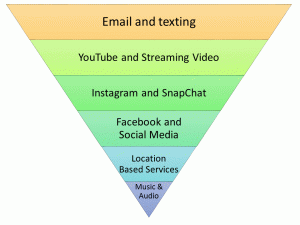Imagine you acquired the most amazing, technologically advanced, web-connected television in the world. Now imagine that TV only works on a coin-operated service – every time you deposited a special (very expensive) coin you’d get a certain number of minutes to enjoy the marvelous device. If your supply of coins was limited, what would you do with those precious minutes you pay for? Would you listen to music, or would you watch TV, movies and surf Facebook and the web? On such a platform, audio-centric content cannot compete for your time against the video-centric content for which it was created. Therein lies the misunderstood dilemma of audio content mobile distribution to smartphones.
In the US, terrestrial radio continues to boast weekly listenership at around 265 million people despite the proliferation of smartphones and the refusal of people to carry transistor radios. Mobile consumers of audio continue to seek audio content via radio, while reserving their smartphone usage for work or for more visually-oriented and data-centric activities and apps.
Current named players in the mobile audio space – Pandora, Spotify, iHeartRadio, Slacker, Audible, and many dozens of others including SiriusXM – have targeted smartphones as their sole platform of choice to reach the mobile audience. The problem with this strategy is that it ignores the mass market and what I’ll introduce and dub here the Mobile Data User’s Hierarchy of Needs (with respects to Malthus).

The Mobile Data User’s Hierarchy of Needs
Few subscribers can afford the unlimited plans so heavily promoted by carriers; many pay as they go or opt for lower cost metered plans than inflict financial penalties if exceeded. Extrapolating from the scenario we opened with, consider the plight of countless millions of subscribers whose data use is limited or metered – how might they prioritize their use of their gigs… Video? GPS? Email? SnapChat?
Audio content certainly does not fall high on the priority list relative to texting, email, location services and video-centric applications. And so we learn that those data plans which enable mass access to audio apps also weigh heavily as the limiting factors restricting broader consumption of audio on smartphones.
The greatest lesson audio content providers can learn from the Mobile Data User’s Hierarchy of Needs is that their smartphone apps are not just competing against each other, but they are also competing with video, games, social media and essentially every app in existence. Audio cannot compete on this video-optimized platform.
In a nation where there are as many mobile telephones in use as there are radios and people, why would an audio content provider of sound mind (pun intended) chose this self-limiting channel to market? Fewer than half of all mobile subscribers carry smartphones; where is the upside to data-delivered audio content mobile distribution?
A better solution is already built-in
Going back to our TV example at the beginning of this post, let’s now imagine our super coin-operated device also had a built-in radio that operated independently and required no coins. What if you were able to access your own continuous stream of personalized audio content without having to feed coins into the TV? Out of special coins? No worries…listen to something.
Are you following the analogy yet?
All smartphones come with a built-in voice telephone – a two-way radio that is optimized for sound (two-way = interactive). That wonderful, audio-optimized device we know as the mobile phone is now in the hands of every human on the planet. The telephones operate independently of the data and web; continued use of the telephone function is unaffected by the status of a subscriber’s data consumption.
Why limit your potential audience for audio by targeting only those using a smart, video-optimized platform? Why add an extra layer of coin (the carrier’s monthly data plan) to a prospective subscriber/listener’s ability to trial and buy your service? Remember: whatever your monthly content subscription fee might be is accompanied by a carrier-imposed $30-80 surcharge that dwarfs your fee. How many more subscribers might you attract were you to eliminate this third-party surcharge?
Welcome to SaraConnects. The technology of Sara is designed to instantly transform any telephone into a smart, personalized interactive radio. Access requires only a dialed telephone call or text. No apps, no data, no gigs, no restrictions. Sara’s artificial intelligence is optimized for audio and voice; a personal DJ delivering a hurdle-free experience for new and prospective listeners to discover and enjoy a provider and its content without the effort of downloading, registering and expending gigs. Sara enables direct-to-consumer distribution for your brand and content through any telephone regardless of technology, infrastructure or location.
Are you interested in expanding the mobile audience for your audio content? Impatient with the rate of reach of current initiatives to grow revenue from audio content mobile distribution? Let us show you how you can double or triple your prospective audience overnight. https://saraconnects.world/contact






